SUBJECTS
GRADE
Show Results
Prefixes
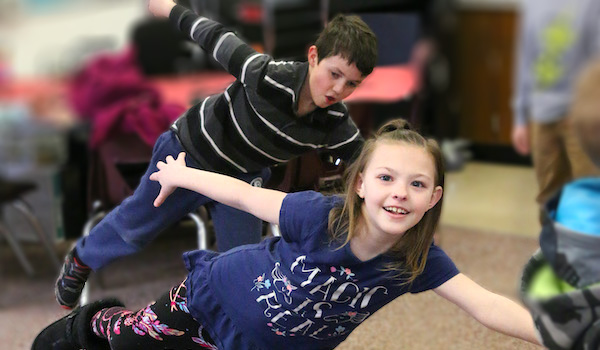
Lesson Summary
- Use the prefixes un- and re- to make creative dance choices.
- Use retrograde and repetition to rewind and repeat a dance sequence.
Lesson Plan and Procedure
Lesson Key Facts
- Grade(s): 2
- Subject(s): Dance, English Language Arts
- Duration of lesson: 45-60 minutes
- Author(s): Erika Cravath
Experience/Identify
Activity 1: Changing Choices
Open space is needed for this activity.
Teacher: Choose one way to move. It can be fast or slow, big or small. You can use your arms or your legs. There are so many ways to move! However, you can choose only one, and you have to stay in one spot. Put your hand on your head when you know what kind of movement you're going to pick. When you hear the music, let’s see your choice!
Turn on music and move through the space, pointing out interesting choices that you see. Have the students freeze and turn off the music.
Teacher: What great choices you each made! Now, every time I change the music to a new song, you need to choose a new way to move. Stick with your choice until you hear the music change, then try something new and different.

After rotating through music and movement choices for a couple minutes, have the students relax but stay in their spot. Write some of the choices you saw on the board while pointing out which students made them. (For example: soft, fast, low, jump, sharp, high, and so on.)
Select three or four students and put a paper crown on their heads.
Teacher: This time when you hear the music, pay attention to more than just the choices you're making. These four students are each wearing a Crown of Change. They're the only students allowed to move to new places in the room. They are going to walk around and find a dancer to stand next to. They'll freeze with their arms stretched out toward the chosen dancer, like they are presenting them.
Demonstrate and model the instructions for the class.
Teacher: The chosen dancer will change the movement he or she is doing. Movement can be changed only when a King or Queen of Change freezes next to you. Once they've selected a dancer and changed the movement, the Kings and Queens will move on and choose a new dancer to change.
Give the students time to dance with different selections of music and change their movement when approached by a crown-wearing King or Queen of Change. If there is time, you can rotate students in the roles.
Activity 2: Introduction of Prefixes
Gather the students in front of the board and write out the bulleted list of words.
Teacher: Every word has a meaning. Look at the words on the board. Turn to your partner and discuss what each of these words mean.
Make sure that the meaning for each word is clear before continuing. You can have the students use their hands and arms to show the physical action associated with each word.
- Twist
- Do
- Tie
- Roll
- Movable
Teacher: A prefix is a group of letters that can be used at the beginning of a word to change its meaning. Each prefix has its own meaning and changes the word in the same way every time.
Place the word cards with the prefix un- in front of the words and discuss how adding those two letters changes the meaning of each word. Do the same with re-.
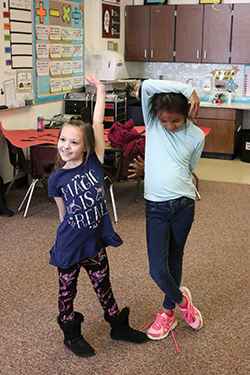
Teacher: Re- means “again” and un- means “not” or “to reverse.” We can do the same thing in dance. Let’s figure it out!
Have the students spread back out and guide them through each of the movements listed on the board. Use either un- or re- before the word to change how the students are dancing. Explore twisting, untwisting, and retwisting, as well as rolling, unrolling, and rerolling.
If students are wearing shoes, have them untie and retie the laces. If they are not wearing shoes or do not have laces, have them find something else to untie and retie or mimic the action.
For the verb do, have the students choose one action to pantomime, undo the action, and then redo it.
For the word movable, begin by having the students dance to one of the music selections (movable). When the music stops, challenge the students to freeze in a shape and stay in it, no matter what. Walk around and gently try to move students by pushing or pulling on their shapes (unmovable). Next, “re-move” students from their frozen spots by guiding them to the sides of the room, or turn on the music and have them “re-move” by dancing again.
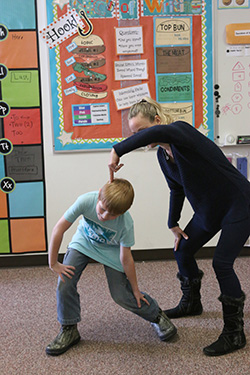

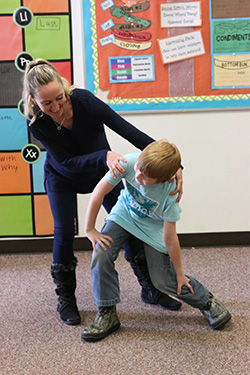
Explore/Investigate
Activity 3: Undo and Redo a Sequence
Send the students back to their first spot. Teach them a simple movement phrase that travels to one side (for example: step together, step together, jump, jump, jump—with all steps and jumps moving to the right). Ask the students to figure out how to do the sequence in reverse (all to the left: jump, jump, jump, step together, step together).
Teacher: Students, we just “undid” our dance! We have a special word that means to reverse in dance: retrograde.
Put up the word card for retrograde and have the students say it several times.
Teacher: Can anyone figure out how to say the word retrograde in reverse? (The answer is edargorter.) Doing this sequence in retrograde is like putting the prefix un- in front of our dance.
Have students perform the original movement to music (for example “Dancing Digits” has an easy beat to follow), then immediately move into the retrograde of the original. Students should travel away from and dance back to their beginning spot.
Have the students dance the original sequence, then repeat it the same way again without stopping between the repetitions. If space is cramped, have the students turn around to face the opposite direction after doing it once. This way, when they repeat the sequence, they will be traveling back to their original spot.
Teacher: Now we’ve put the prefix re- on our dance! The dance word for this is easy to remember: repeat or repetition.
Have the students perform the original sequence, then the retrograde, and then the repetition (doing the original two times in a row). Mix up the order by using the cues retrograde and repeat in varying patterns. If there is time, you can also use a visual cue of holding up the prefixes un- and re- on separate cards to tell the students which sequence they should perform: the retrograde reversal or the repetition.
Activity 4: Read If You Were a Prefix
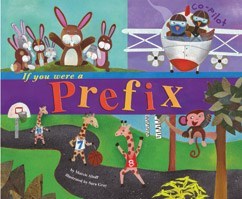 Teacher: There are many different kinds of prefixes. Let’s read about some more of them. If you pay close attention, you may notice the two we already know about. Tap your nose when you hear un- or re-.
Teacher: There are many different kinds of prefixes. Let’s read about some more of them. If you pay close attention, you may notice the two we already know about. Tap your nose when you hear un- or re-.
Read If You Were a Prefix.
Optional activity: Facilitate a discussion about what other prefixes students heard in the book and what each means. Use these new prefixes to explore movement. (For example, transform movement: movement changes and alters; co-dance: partners dance together; and tele-dance: copy one person dancing from across the room.)
Activity 5: Shape Chain
Mark three spots on the floor.
Teacher: I need three line leaders. The line leaders will dance through the space to this spot, then make a shape and freeze. They can choose to make any kind of shape: high or low, curved or bent, small or big. Once they're frozen in their shape, the next person in line moves through the space and finds a way to make a shape that connects to the first person’s shape. You can use any kind of appropriate connection: hand to back, foot to foot, head to knee—but be creative! However, one rule is your head cannot be at the same level as the person before you.
Have the line leaders dance to their spot and freeze, then have the next person follow, then the next, and so on. All students should join onto the frozen shape line. Once this “shape chain” is created, ask students to close their eyes.
Teacher: Memorize where each part of your body is. Ask yourself, “Could I recreate this shape in the same order in my chain?”
Have students open their eyes.
Teacher: Now let’s retrograde! We'll undo our shape chain in the opposite order that we used to create it.
To do this, have the person who added onto the line last undo his or her shape, then make his or her way backward to the end of the starting line.
Teacher: Even though you're traveling backward, make sure you're smart in your space. Use your eyes and don’t run into anything.
Once he or she is in the spot at the end of line, the next person in the shape chain can do the same until everyone is back in line. Have the students redo the shape chain and challenge them to make it exactly the same as it was before.
Create/Perform
Teacher: I’m thinking of one of our new dance words. This word means to do something backward. What word am I thinking of? (Retrograde.) How about the word that means to do again in the same way as the first time? (Repeat.) We'll use these dance words as tools to help us create a dance about the prefixes we learned today.

Using the word list in the second activity as inspiration, assign one movement per word. Ask for ideas from students as to what each movement should be. Connect the words and movements together into a sequence. Have each student find a partner, and together have them go through each movement in the new sequence and figure out how to retrograde the movement.
After all students successfully do the original movements in order, as well as retrograde each element of the sequence, have each student choose two parts of the dance. When they get to the part they selected, have them repeat that one part before continuing the dance. This means when they dance their sequence, their dance will look a little different than everyone else’s.
Demonstrate this for the students by choosing one part to repeat within the sequence as a whole. Have them tell you which part they saw repeated. Have the students practice their own dances with the two repetitions.
Now have students choose one part of the dance to retrograde. Just like their repetitions, students will now plug one retrograde into their sequence. Again, every dancer will now have their own version of the same sequence. Allow the students to practice retrograding a portion of the sequence within their dance.
Divide the class into three groups. Space them around in the room and have them face the center. One group will perform their dances for the rest of the class. Have them perform to music used earlier. Remind audience members to watch respectfully without talking and look for moments in which their classmates chose to repeat or retrograde. Ask students to identify what retrogrades and repetitions they saw in their classmates’ dances. Rotate through all three groups.
Connect/Analyze
Gather the students in a seated group and guide them through several deep breaths. Discuss the following questions with the students:
- Where else in the world do you see retrogrades and repetitions?
- Why do you think knowing prefixes is important? Can a prefix give you clues about the word’s meaning? How do you think this helps you in other places, outside of dance?
Learning Objectives
- Know and apply grade-level phonics and word analysis in decoding words.
- Decode words with common prefixes and suffixes.
- Reflect on movement choices and change movement through guided improvisational experiences or short remembered sequences.
- Demonstrate a variety of movement qualities while dancing.
Utah State Board of Education Standards
This lesson can be used to meet standards in many grades and subject areas. We will highlight one grade’s standards to give an example of application.
Grade 2 Dance
Standard 2.D.CR.1: Demonstrate willingness to work with partners when creating dance.
Standard 2.D.CR.2: Explore movement inspired by a variety of stimuli.
Standard 2.D.CR.4: Reflect on movement choices and change movement through guided improvisational experiences or short remembered sequences.
Standard 2.D.P.1: Move safely in general space through a range of activities and group formations while maintaining personal space.
Standard 2.D.P.6: Demonstrate a variety of movement qualities while dancing.
Grade 2 English Language Arts
Standard 2.R.9: Determine or clarify the meaning of unknown and multiple-meaning words and phrases, choosing flexibly from a range of strategies. (RL & RI)
Standard 2.R.3: Demonstrate mastery of age-appropriate phonics skills...Decode words with common prefixes and suffixes.
Standard 2.R.9: Determine or clarify the meaning of unknown and multiple-meaning words and phrases, choosing flexibly from a range of strategies. (RL & RI); Determine the meaning of a new word when a known prefix or root is used.
Equipment and Materials Needed
- Aboff, Marcie, and Sara Jean Gray. If You Were a Prefix. Place of publication: n.p., Picture Window Books, 2008.
- Paper crowns or similar designators
- Word Strips:
- Re- means “again”
- Un- means “not” or “to reverse”
- Twist
- Do
- Tie
- Roll
- Movable
- Un-
- Re-
- Retrograde
- Repetition
- Word Cards:
- Un-
- Re-
- Retrograde
- Repetition
- Music and speakers
Additional Resources
Music that could be used (a variety of energy, tempos, and sounds) :
- “Dancing Digits” by Eric Chappelle
- “Mr. E” by Eric Chappelle
- “Clocks” by Vitamin String Quartet
- “Planxty Irwin” by Eric Chappelle
- “Udu Chant” by Mickey Hart
- “Vieni a Summerville (Instrumental—Base Musicale)” by Inestate
- “Amphibious” by Eric Chappelle
- “Waterfall” by the Piano Guys
- “Me and My Cello (Happy Together)” by the Piano Guys
Image References
Images 1–6: James Huston.
Image 7: Goodreads (https://www.goodreads.com/book/show/6462241-if-you-were-a-prefix).
Image 8: James Huston.

www.education.byu.edu/arts/lessons
 Download
Download